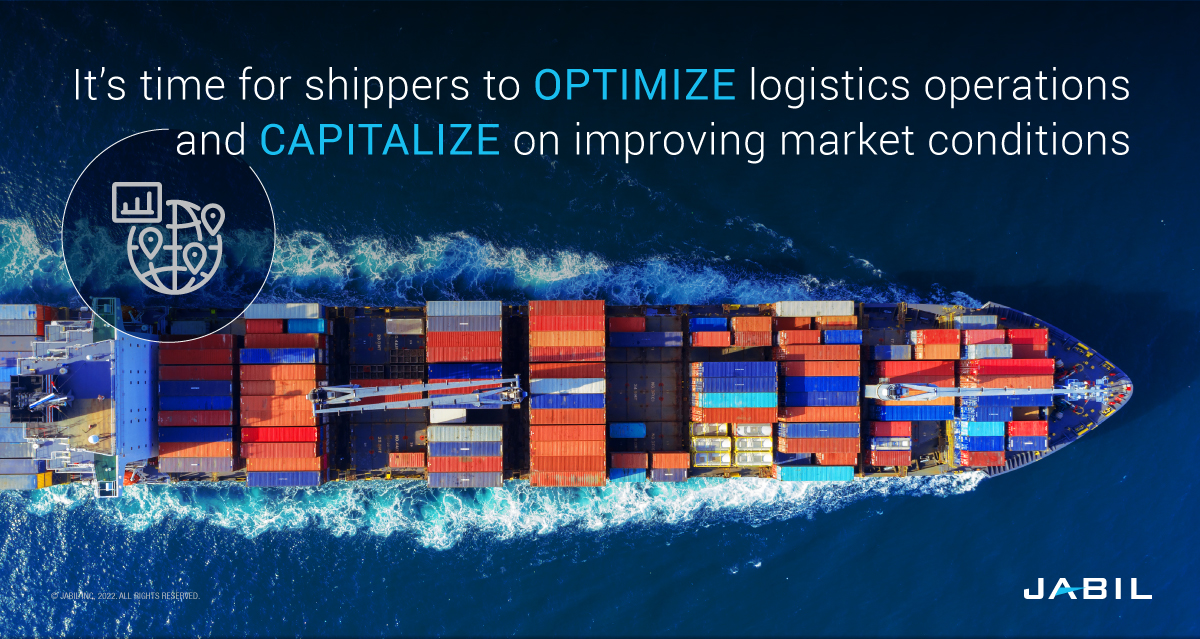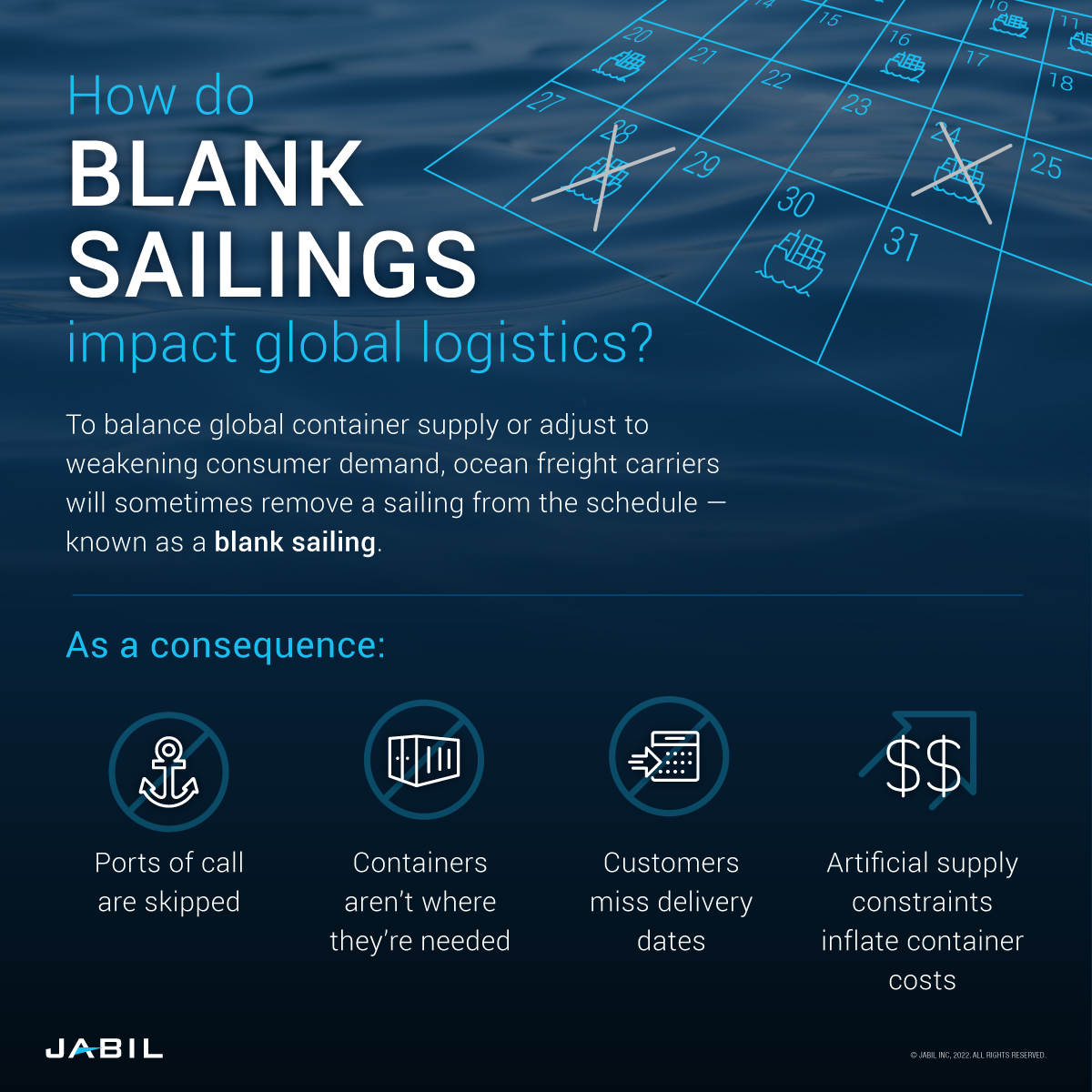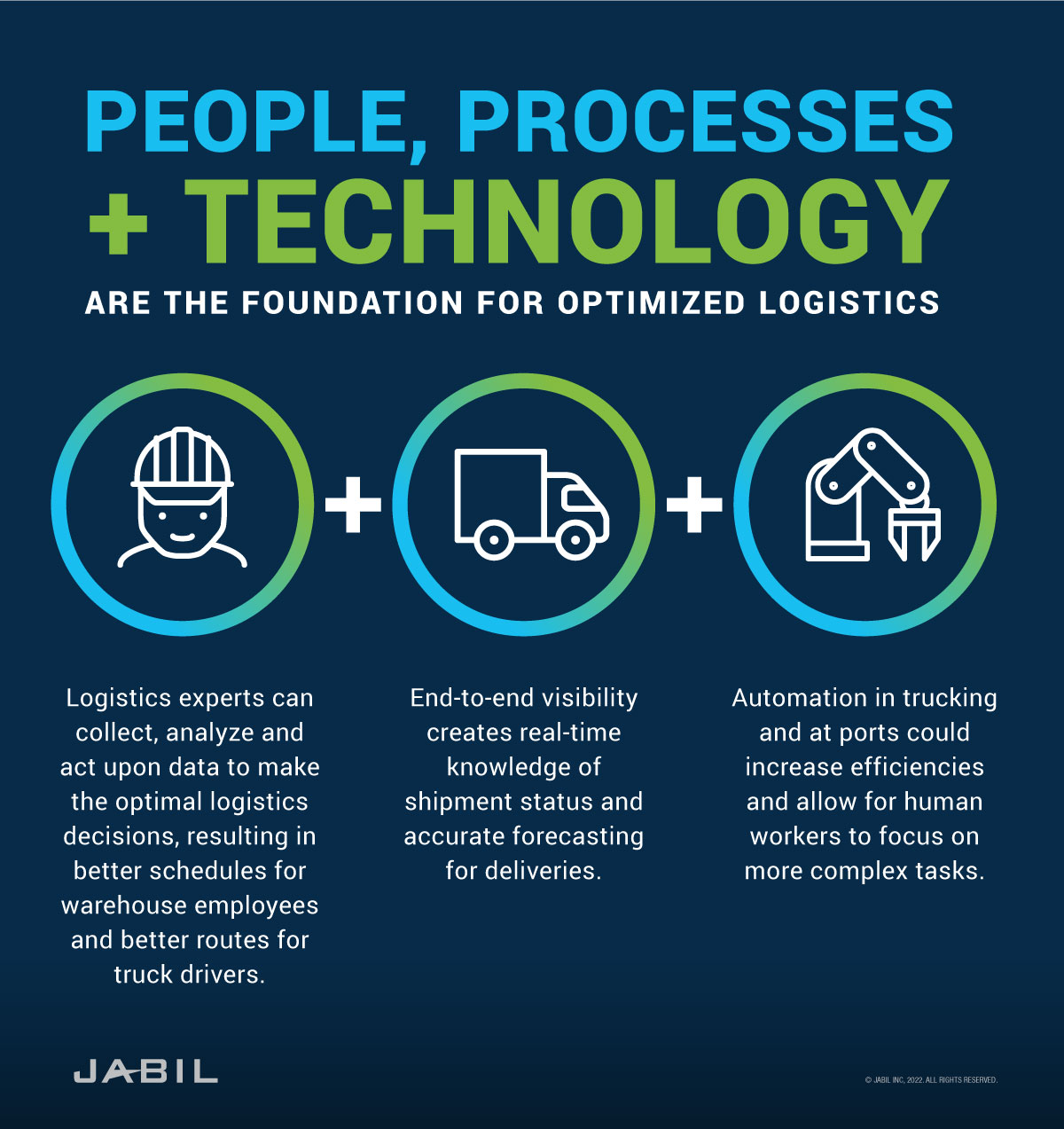Changing Tides: Preparing for the Next Logistics Disruption

After the global logistics and freight industry was hit hard by the Great Recession in 2008, they took one lesson into the next decade: Optimize. Get lean, and get efficient. The trucking, rail, air cargo and maritime industries grew slowly but steadily, integrating new supply chain technologies to maximize efficiencies and keep costs down rather than add significantly to their fleets or warehouse footprint. Keeping operations tight and resisting the urge to expand too quickly helped logistics companies successfully navigate small global logistics disruptions as they came — like lower-than-expected demand, the rise of e-commerce and increasingly common weather phenomenon.
Then, of course, came the cycle of disruptions we've seen throughout the early 2020s — COVID-19, soaring demand, labor shortages and port bottlenecks, to name a few. Geopolitical challenges like the Russian invasion of Ukraine put additional pressure on an already stressed system.
Some companies are anticipating that these so-called "COVID-era" logistics challenges may persist. In a global supply chain survey Jabil conducted in partnership with IndustryWeek in January and February 2022, 41% of supply chain professionals surveyed across a wide range of industries said they believe delayed shipments will continue beyond the pandemic. Issues like an imbalance of containers, mispositioned containers and railroad strikes will all likely continue to impact port operations around the world in the months and even years to come.
Unclogging the logistics pipeline has taken time and patience, but it has been mostly cleared of the worst slowdowns. In the long term, companies must think about how best to optimize global logistics to prepare for the next inevitable disruption.
First, though, let's dive deeper into the connections between each piece of global logistics. A bottleneck in any one of these segments — from port closures to labor shortages — impacts the others. A bottleneck in all can grind the system to a near halt.
Download the Supply Chain Readiness Report.
What Are the Current Global Logistics Conditions?
Uncertainty and fluidity will always be the name of the game in logistics. Changing economic conditions are always quickly reflected in logistics, something we've seen throughout 2022's shifting capacities across shipping modes.
Across the board, though, capacity is up; shippers have momentum and leverage for the first time since before the outbreak of COVID-19. It's time to use that advantage to optimize logistics operations and capitalize on these improving market conditions.

Air
As COVID restrictions have become more targeted to highly specific areas, shippers and logistics professionals have begun to gain back some of the logistical flexibility we have lost in recent years, especially in air freight. Overall, belly capacity remains down in some lanes (particularly outbound Asia) compared to pre-COVID levels, but we're seeing massive improvements globally. Cargo capacity on critical long-haul international flights (specifically between North America and Asia) is only about 12% below 2019 levels as of summer 2022, though industry experts believe that capacity won't fully recover until 2025.
This bounce-back is being aided by passengers' steady demand for air travel worldwide. In North America, demand has almost returned to pre-pandemic normal; IATA reported that 88% of available passenger seats on North American flights were full in July 2022.
However, demand for air freight has begun to drop, signaling the possibility of weaker consumer demand due to inflation. Additionally, while air freight rates are higher than they were in 2021, they have been relatively stable throughout 2022. Geopolitical conflicts and rising energy costs could add pressure to air freight costs as we look to the future, but shippers are in a much better position than they have been in the past few years to negotiate lower prices on air cargo.
Ocean
In some regards, ocean shipping has moved much closer to its pre-COVID state. Freight rates are falling from the historic highs we saw in 2021, and the flood of shipments from retailers and manufacturers is stagnating in some markets as high inflation is starting to create shifts in consumer buying patterns.
Still, two lingering challenges are likely to persist for some time. First, overall ocean freight reliability is improving slightly but continues to be a driving issue globally. In Asia, ocean shipping's on-time average is 40.5%, lower in specific lanes. In the U.S., inbound freight only averaged 35% on time in 2022.
The second challenge is ocean container displacement caused by ocean carriers "blanking," or voiding, sailings. A significant number of these blank sailings have been on Asia to North America routes in order to help balance container supply with weakening consumer demand. A consequence of this strategy is that scheduled ports of call are skipped, containers aren't where they're needed, and potentially time-sensitive shipments don't make it to their destination before goods are spoiled or customers miss their delivery dates.
These canceled bookings also work to slow the gradual decrease in container shipping rates by artificially constraining supply. Despite this challenge, spot indexes are generally all pointing in the same direction; there is no precipitous plunge in container shipping rates, but they are on an orderly decline.

Land
Demand in the LTL market in the US and Mexico decreased throughout the summer of 2022 concurrently with consumer demand. While this drop in freight volume gives shippers greater flexibility between logistics modes (railroad vs. LTL vs. air), it has caused significant bottlenecks at warehouses.
With consumer goods sitting longer on store shelves, retailers are leaving their imported goods in warehouses instead of shipping them inland. This practice is triggering lengthy delays for the containers that can't be unloaded until space is created inside these at-capacity warehouses.
Additionally, a U.S. railroad strike was averted in September 2022, but until the union contract is signed, the potential for disruption to ground logistics is being monitored closely. Recent and ongoing strikes at European ports and airlines demonstrate how labor unrest can increase congestion in various logistics modes.
Natural disasters, economic conditions, geopolitical crises and pandemics all can and have changed the landscape of global logistics on a dime — for better or worse. Without an optimized logistics strategy, at best you're giving up opportunities for more cost-effective, efficient shipping. At worst, you could be sending your shipments into a costly, time-consuming bottleneck when disruptions inevitably strike — if you can even find a way to ship your goods at all. The key is to plan when the waters (or the air, or the road) are steady for when things get bumpy.
How Can We Optimize Global Logistics in a Highly Disruptive Supply Chain?
When logistics are operating smoothly, they can sometimes fade into the background of an organization — shipments arrive where and when they should and at a predictable cost. But as on-time reliability has dropped while costs have climbed, logistics has suddenly become much more visible within most organizations.
Now that logistics and other supply chain functions have been given a seat at the leadership table, or at the very least been given a higher degree of importance, it's time to use that leverage and build a futureproof logistics strategy within your overall supply chain roadmap.
At Jabil, we describe the supply chain in terms of its people, processes and technology. The right combination of these three elements is the foundation for a successful, resilient supply chain — and an optimized logistics strategy.

People
Individuals with the expertise to collect, analyze and act on data are key to making logistics decisions, especially when the waters are rough. If you have two possible routes, what are the transit times of each? When is the product needed at the destination? What is the tonnage and value of the shipment? What is the on-time percentage of the logistics carrier in question, and what technology are they using? Answers to all these questions will help you achieve the ultimate goal of logistics: improve on-time delivery, reduce the cost of the shipment and reduce the transit time of the shipment.
Achieving the goals of lower logistics costs and effective logistics management starts by improving the experience of logistics and warehousing workers. In warehouses, knowing when and how much product to expect will help create more accurate and reliable employee scheduling; fewer shifts will need to be canceled or scheduled at the last minute. Long-haul truck drivers can plan to show up to a port when a container is ready to be unloaded and not be stuck waiting. An optimized transportation management strategy, from choosing the right driver to analyzing route options to minimize slowdowns, can help get trucks where they're needed most, improve the retention rate of truckers and begin repairing the industry's labor shortage.
According to Jabil and IndustryWeek's survey, technology has played a crucial role in putting logistics labor where it needs to go. Almost a quarter of respondents (23%) said they implemented a transportation management system during the pandemic to improve supply chain performance, while 24% are considering implementing one in the next 12 months. Similarly, 21% implemented a warehouse management system during the pandemic, and 22% plan to introduce one in the next year.
Communicating with carriers and logistics partners can give you even more information to prepare for what's ahead, from container availability to pricing increases. Good partnerships prevent your company from getting burned when a carrier needs to decide where a container ship is sent or who gets space on it.
Processes
Processes can help reach the logistics goal of on-time deliveries, lower-cost shipments and quicker transit times. The name of the game is visibility. Businesses want the same level of information about the status and location of their goods in production as consumers do about theirs on the way to the mailbox.
From a logistics perspective, this looks like the ability to know not only which container ship your components are on, but where on the ship they're sitting, exactly when they make it to the port, when they're unloaded, and where they are in the warehouse. Gaining the level of visibility companies want into the logistics process takes a sophisticated digital system of sensors or tags to indicate where shipments are at any given point. Almost half (49%) of survey respondents said they have deployed third-party tools and services to provide real-time data on capacity and mode (air, ocean, truck, rail) availability within the past year or plan to do so in the next 12 months.
With end-to-end visibility, logisticians can use predictive analytics (something 77% of respondents plan to invest in within five years) to design optimized routes and more accurately forecast what's to come for a company's shipment. For example, if it's determined a particular route is the optimal one using predictive analytics, those analytics could also be used to predict that what would normally be a 65-day transit time will actually be 90 days because of port congestion or a pattern of blanked sailings on that route. A logistics as a service partner can offer technologies and expertise to support the efforts of an in-house supply chain and procurement team.
Technology
The pandemic accelerated the already-growing use of logistics visibility solutions that integrate with your existing supply chain systems and partners and allow you to track shipments across transportation modes. These types of solutions leverage both the micro (shipment-level data gleaned from sensors) and the macro (status updates about ports of interest) to provide seamless insights for your entire logistics operation. Nearly three-quarters (72%) of respondents showed interest in implementing a track-and-trace solution over the next five years.
In recent years we've also seen increasing adoption of automated robots in warehouses for repetitive activities like picking and packing. While there's been extensive discussion about automation and artificial intelligence in manufacturing to create the factory of the future, I think the same could be said for the "port of the future."
Ports are just beginning to invest in automation and other digital technologies, a consideration that could grow with the increasing longshoreman shortage. A 2021 report from the International Transport Forum found that only 53 container terminals worldwide have automated capacities, or 4% of global container capacity. Currently, most automated systems are found in the container yard, to lift or stack containers. Before adopting automated or digital technologies at random, ports should first analyze their pain points to determine where those systems could most benefit their operations.
With people, processes and technology in place, logistics will be the final link in your resilient supply chain.
How Do Optimized Global Logistics Contribute to Supply Chain Resiliency?
As the pace of disruptions increases, the question is not "if" your supply chain and logistics strategy will be tested, it's "when." A resilient supply chain doesn't break when it's pushed. It bends, then quickly bounces back.
Optimizing global logistics by making them predictive and proactive is crucial to building a supply network that can withstand the next disruption. Two-thirds of Jabil and IndustryWeek survey respondents rated logistics management as a 4 or 5 on a scale of 1-5 measuring its importance to optimizing the effectiveness of supply chain resiliency.
First, build relationships with your shipping partners that you can lean on for favorable pricing and agreements when you need them, but don't lock yourself into long-term agreements. Work with the market as it ebbs and flows to take advantage of the best prices. Also, the freighters you're working with likely know their routes better than anyone; ask them questions, learn from them, and work with them to find creative solutions when logistics issues arise.
Then, like you would have multiple suppliers for a component, have multiple supply route options. Changing ports, putting three or four modes of transportation together to move products: These are not steps we would have taken before March 2020, but the pandemic and the increasing velocity of natural disasters have likely forever changed how we approach logistics.
Be flexible. Be creative. Most importantly, be proactive. With a visible, predictive logistics plan in place, not even a container ship stuck in the Suez Canal can send your supply chain off course.
Global Supply Chain Readiness Report: The Pandemic and Beyond
Insights from over 700 decision-makers at OEMs across seven key industries that pinpoint how the pandemic has been impacting supply chains and how organizations are changing in response.